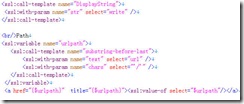Improve User Experience in Enterprise Search Step By Step - Part II
In Part I we discussed on how to change the style of the results. But this is not enough, what about to show other things in result items? (This is a request from https://forums.microsoft.com/MSDN/ShowPost.aspx?PostID=2387134&SiteID=1)
Scenario II. Show me the path!
When you search for something, a XML result table will be returned and transformed by XSLT to show the final result. It contains different properties so you can use them,for example:
<item>
<title>Hello World!</title>
<url>file://superman/opal/myresume.doc</url>
</item>
So we can get url value from this table, and show it.
How to show the path file://superman/opal ? If I only want the path of the url not the file, "myresume.doc" should be cut off. But XSL is not a good way to process string, luckily some people already showed us some examples and we can use them.
In this example, we used a template in https://xsltsl.sourceforge.net/.
Insert the following template into core result webpart XSL.
<xsl:template name="substring-before-last">
<xsl:param name="text"/>
<xsl:param name="chars"/>
<xsl:choose>
<xsl:when test="string-length($text) = 0"/>
<xsl:when test="string-length($chars) = 0">
<xsl:value-of select="$text"/>
</xsl:when>
<xsl:when test="contains($text, $chars)">
<xsl:call-template name="substring-before-last-aux">
<xsl:with-param name="text" select="$text"/>
<xsl:with-param name="chars" select="$chars"/>
</xsl:call-template>
</xsl:when>
<xsl:otherwise>
<xsl:value-of select="$text"/>
</xsl:otherwise>
</xsl:choose>
</xsl:template>
<xsl:template name="substring-before-last-aux">
<xsl:param name="text"/>
<xsl:param name="chars"/>
<xsl:choose>
<xsl:when test="string-length($text) = 0"/>
<xsl:when test="contains($text, $chars)">
<xsl:variable name="after">
<xsl:call-template name="substring-before-last-aux">
<xsl:with-param name="text" select="substring-after($text, $chars)"/>
<xsl:with-param name="chars" select="$chars"/>
</xsl:call-template>
</xsl:variable>
<xsl:value-of select="substring-before($text, $chars)"/>
<xsl:if test="string-length($after) > 0">
<xsl:value-of select="$chars"/>
<xsl:copy-of select="$after"/>
</xsl:if>
</xsl:when>
<xsl:otherwise/>
</xsl:choose>
</xsl:template>
This will add a "substring-before-last" template to your XSL. Then search for <xsl:with-param name="str" select="write" />, insert the following string after </xsl:call-template>.
<br/>
Path
<xsl:variable name="urlpath">
<xsl:call-template name="substring-before-last">
<xsl:with-param name="text" select="url" />
<xsl:with-param name="chars" select="'/'" />
</xsl:call-template>
</xsl:variable>
<a href="{$urlpath}" title="{$urlpath}"><xsl:value-of select="$urlpath"/></a>
This means, use substring-before-last to cut strings like file://superman/opal/myresume.doc to file://superman/opal .
This part of XSLT now looks like this:
Apply the setting, you will see the following result:
You can try different things in XSLT, it's very interesting.

